

Get Your Musical Foundation In Place Now!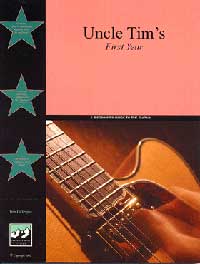
If you are struggling to know what chords are in what key or how the basic scale works within a key, you might be struggling when just a little information might make a HUGE difference.
You don't have to become a rules freak, but taking a little time to understand how a key works can take away ALL of that FRUSTRATION! And this is done visually so you do not need to read volumes to get it, just one thin book (88 pages).
Not knowing can stop your music right now and only understanding can make up for it. For $15, you can put this all to rest right now. Pick up a copy today.
eBooks are delivered instantly!
By Tim Gillespie
Time and time again I answer a fundamental question regarding scale signatures, yet the answer is elusive to many musicians. That is how does a related major and a related minor key work together? A lot of the time, this question is framed in terms of pentatonic scales. People seem to think Pentatonic scales behave differently than the Diatonics. When I would tell them Pentatonics act the same as Diatonics, the glazed look would return to their faces. Another question I continue to hear is how does the Circle of Fifths work?
It seems the Circle of Fifths is as mysterious today as it has been over the course of years.
Today we are going to focus on this single issue. It may appear as two separate questions, however, it is actually the same topic.
If you are trying to memorize all of your scales in every key for the entire fretboard, and you are working through the major and then the minors, you are already working way too hard. With this single article, you should be able to cut your work in half, actually much more if you look deep. If you pay attention to this and work on understanding it, you will be rewarded with some higher level mental abilities.
The Circle of Fifths is easy and it has the potential to open the doors to becoming a better musician. Every person that ever picked up a guitar, can make very good use of this information. It has the potential to make sense of some complicated theory and act as a guide for you as you play with musical concepts.
This article is actually another step in understanding this concept. Major And Minor Tonal Centers was the first article to explain this concept. I suggest you take a look at that edition and work through it as well.
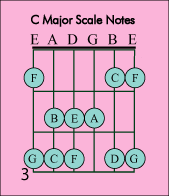 Let's
start by looking at a standard C major open string scale. Once in a
while someone will ask the question, why does this scale start with
the low E note? The scale of C starts with the C note.
Let's
start by looking at a standard C major open string scale. Once in a
while someone will ask the question, why does this scale start with
the low E note? The scale of C starts with the C note.
Yes the scale of C major is constructed by starting on the C note and proceeding with D, E, F, G, A , B and repeating at the next occurrence of C. However it is very important to know, study and use all the notes in the key, regardless of where they occur. You do not always start a run with the keynote, and you certainly do not end every run with the keynote.
Locking yourself into the rigid thoughts that you should or must start with the keynote, will cause a person to lose sight of the necessity of learning all the notes in the key so all the note can be considered when soloing. Remember, in an improvisational setting, you really do not have the time to think and study. You either have the information or you don't.
The Scale Of C Major
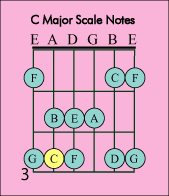
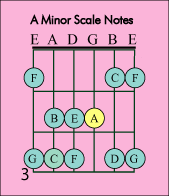 So
what is the difference between these two scales? Answer: nothing.
There is nothing different. They are the same scale. There is no difference.
Yet when people tell me they are memorizing all of their scales, (which
is a very good idea), they usually say they are going to start learning
the majors and then the minors. When I tell them they are memorizing
the minors when they learn the majors, they usually go silent and open
their mouth slightly.
So
what is the difference between these two scales? Answer: nothing.
There is nothing different. They are the same scale. There is no difference.
Yet when people tell me they are memorizing all of their scales, (which
is a very good idea), they usually say they are going to start learning
the majors and then the minors. When I tell them they are memorizing
the minors when they learn the majors, they usually go silent and open
their mouth slightly.
Or if they are memorizing the Blues scales or, more commonly, the Pentatonics, they will then tell me that trick might work for the majors and minors, but the Pentatonics are different.
Majors And Minors
There are several misunderstandings with this thinking. Here is the first one and the reason I use this as an example. People refer to the diatonic scales as major and minors. In fact every type of scale contains major keys and minor keys. Pentatonic scales contain major and minor keys. When they refer to the Diatonic keys as the major and minor keys and the Pentatonic keys as the minor Pentatonic keys (only), I know there are clarifications they need in order to understand these concepts.
All keys have major and minor tonal centers. Even if the rules of construction dictate they are built on the minor keynotes, there is still a major tonal center attached. So clearing up this level of understanding can greatly increase the overall awareness of music in general. Refer to Diatonic key centers as Diatonic and other types of key centers by their proper name. Use major and minor designations when inside a known type of key center such as Blues, Pentatonic, Diatonic or others.
Tonal Centers
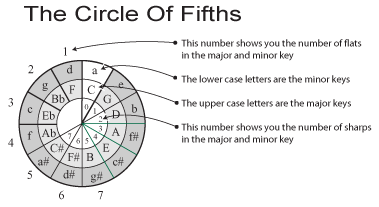 This is not
going to be an in-depth explanation because the true meaning is simple
and I do not want to clutter up the discussion. This diagram can be
used with all the other types of key signatures out there, with the
one exception of the sharps present in the key (the inside circle).
Those will vary because there are different amounts of notes in the
other types of scales (signatures). Here is what I want you to see.
This is not
going to be an in-depth explanation because the true meaning is simple
and I do not want to clutter up the discussion. This diagram can be
used with all the other types of key signatures out there, with the
one exception of the sharps present in the key (the inside circle).
Those will vary because there are different amounts of notes in the
other types of scales (signatures). Here is what I want you to see.
1. The outside circle are the minor keys (lower case letters).
2. The middle circle are the major keys (upper case letters).
3. The inner circle contains the amount of sharps in each key.
4. Each slice represents the scale and the sharps in the key. Notice the keys of A minor and C major occupy the same slice. They both use the same scale and they both have the same amount of sharps (none).
5. The entire corcle represents all the keys available for this scale type.
That is it! Do not look any deeper. Focus on grasping that. Think hard about just that. The last thing we are going to do is look inside a slice again.

 Each
scale (represented by a slice) contains a major and a minor tonal center.
Here is another way of saying that. Each scale contains a major and
a minor tonal center. The scale we looked at (shown to the right) contains
a major and a minor tonal center. The major tonal center is the C major
scale. The minor tonal center is A minor. They both use the same scale.
Each
scale (represented by a slice) contains a major and a minor tonal center.
Here is another way of saying that. Each scale contains a major and
a minor tonal center. The scale we looked at (shown to the right) contains
a major and a minor tonal center. The major tonal center is the C major
scale. The minor tonal center is A minor. They both use the same scale.
If you memorize the major scale for this scale type, you have already memorized the minor tonal center. Now you just need to make yourself aware of that. This is a simple but very powerful concept and as you play the scales of C major and A minor, it will reinforce this meaning.
The exact same thing can be applied to all the other types of keys. I know because I have articulated them all. They are all available in the printable eBooks available at Uncletim.com. They all work the same way, even if the rules tell you they are constructed as minor scales. Believe me, the major tonal center is right there with it too.
All by itself, this will cut down the amount of memorization necessary to learn all of your scales for whatever type of scale you are interested in.
This can be a very difficult concept to grasp when you are just getting started, but if you examine it and think about it over the course of weeks you will begin to see it is true. A very helpful way of understanding this is to test it. Have your friend play something simple in a key and construct a solo over it. Then have them construct a progression in the relative minor key and run the scale again. Just like magic, the same scale will resolve to either the major key or the minor one, depending on how the song was constructed.
I learned this quite by accident. I would be soloing over a song I
though was in the major key. When I went to end the solo on the keynote,
it did not work. The solo was fine, but the ending fell apart because
I sould have ended it on the minor keynote. When I descovered this,
new doors opened. They will for you too!